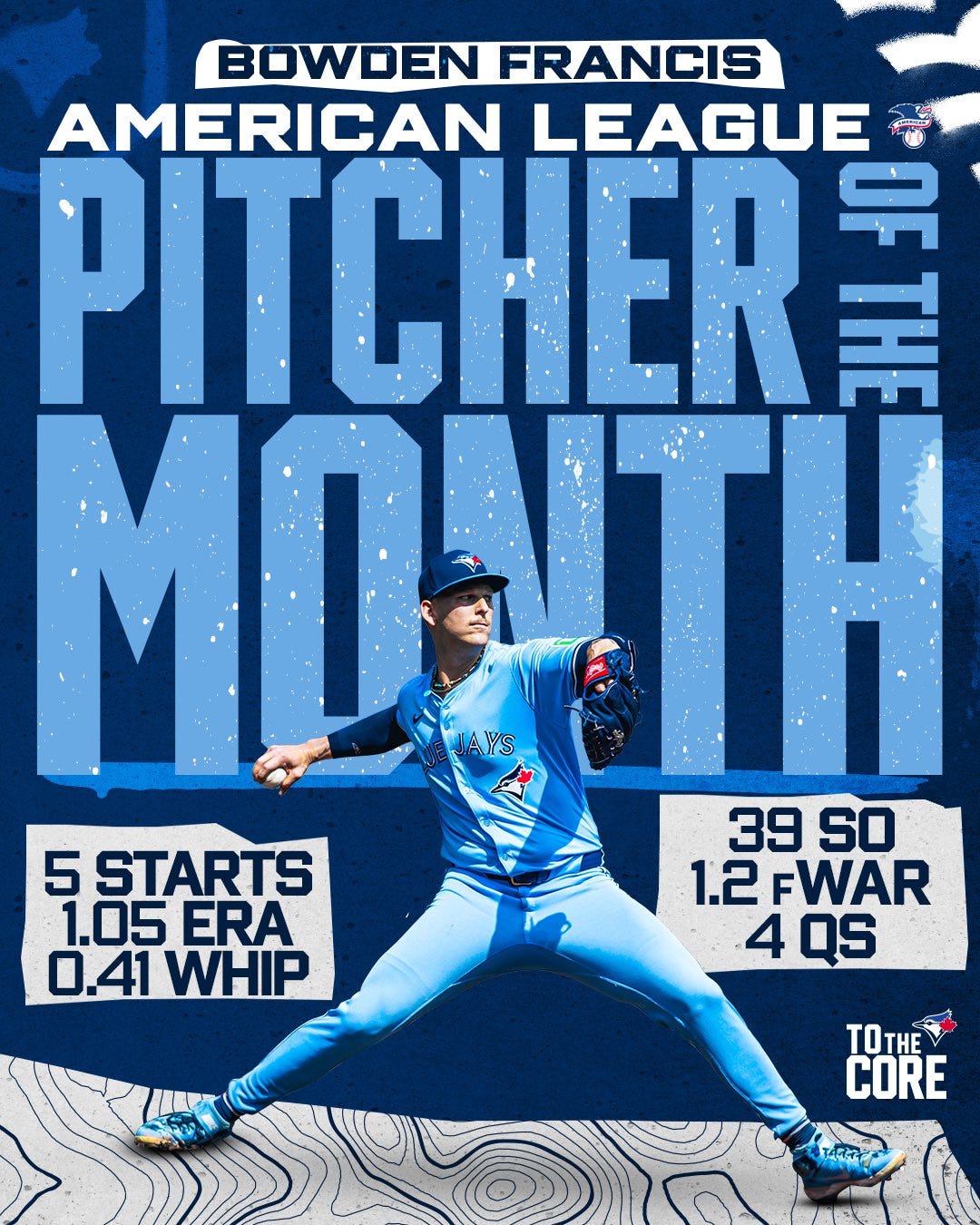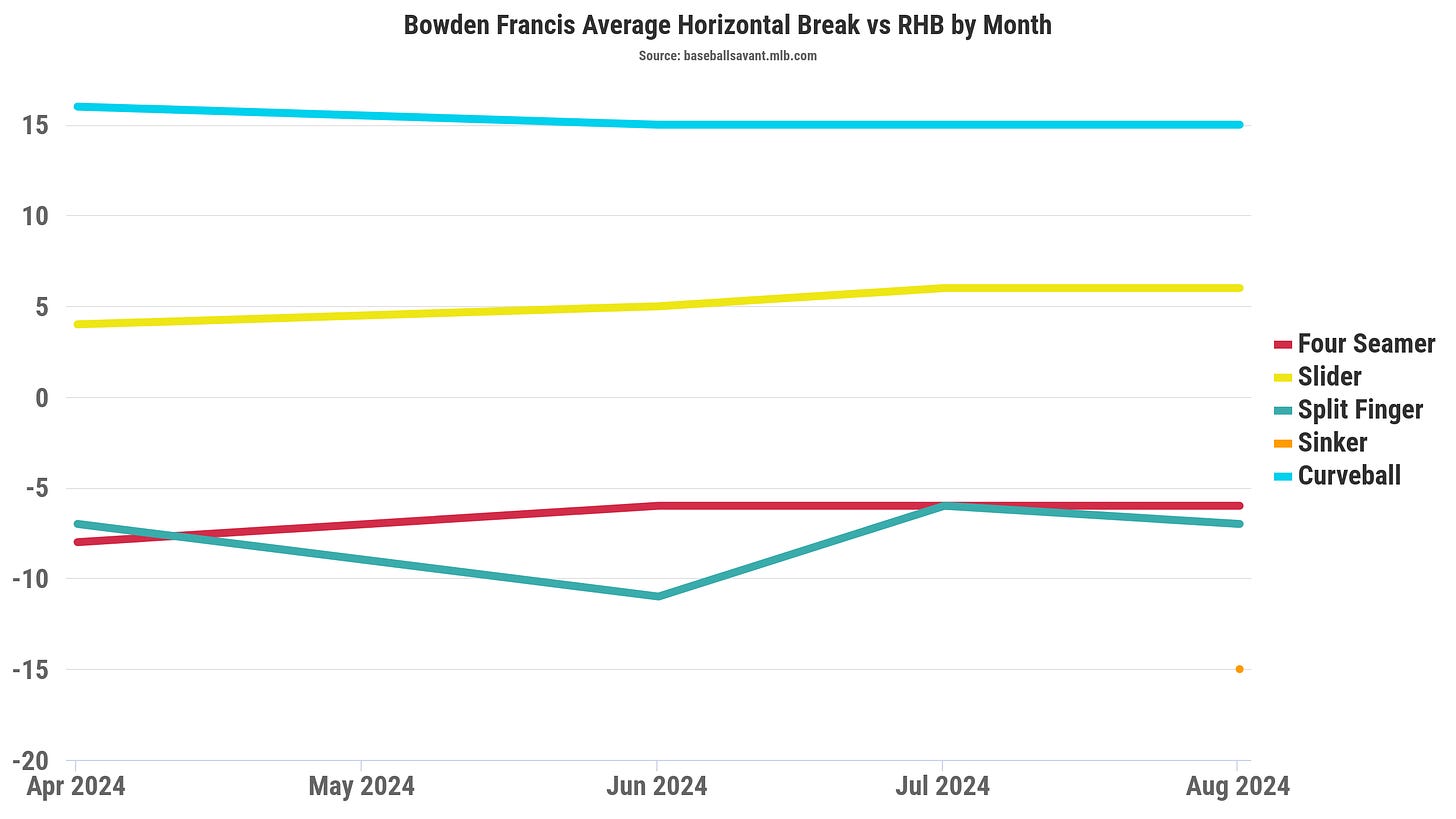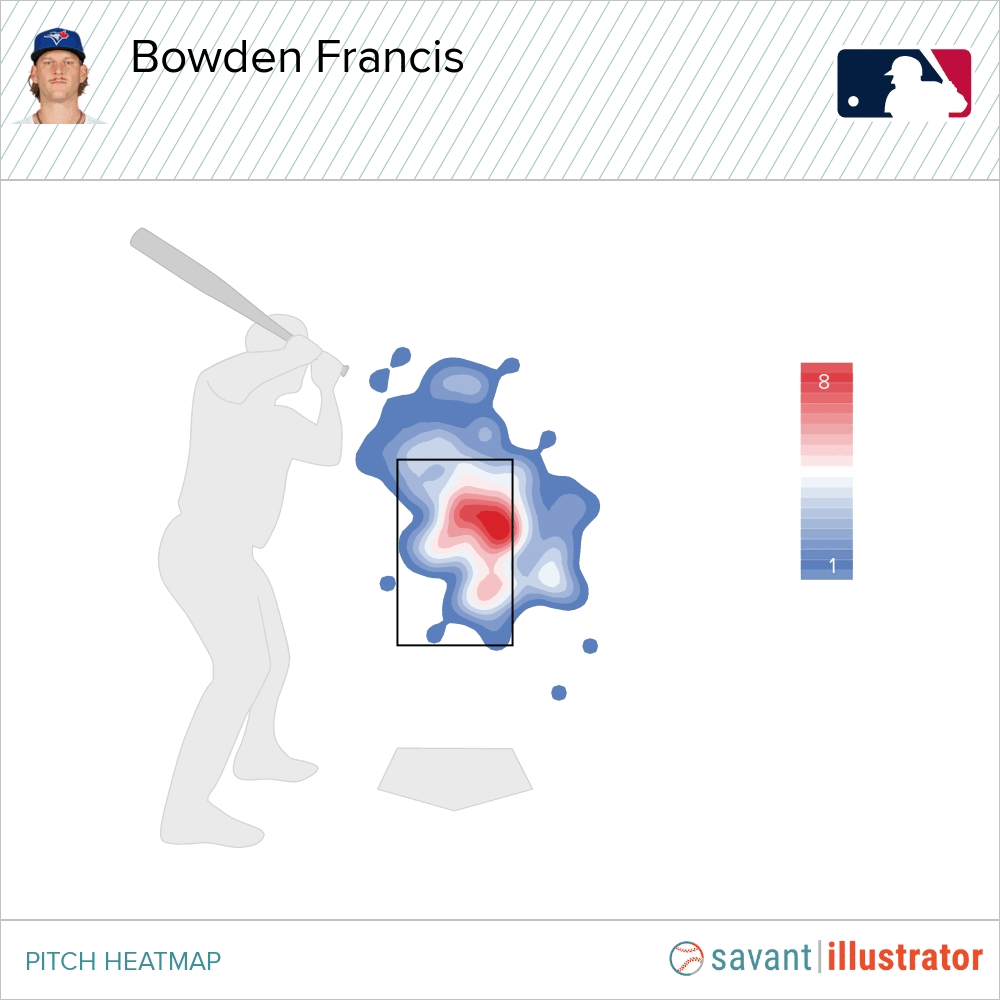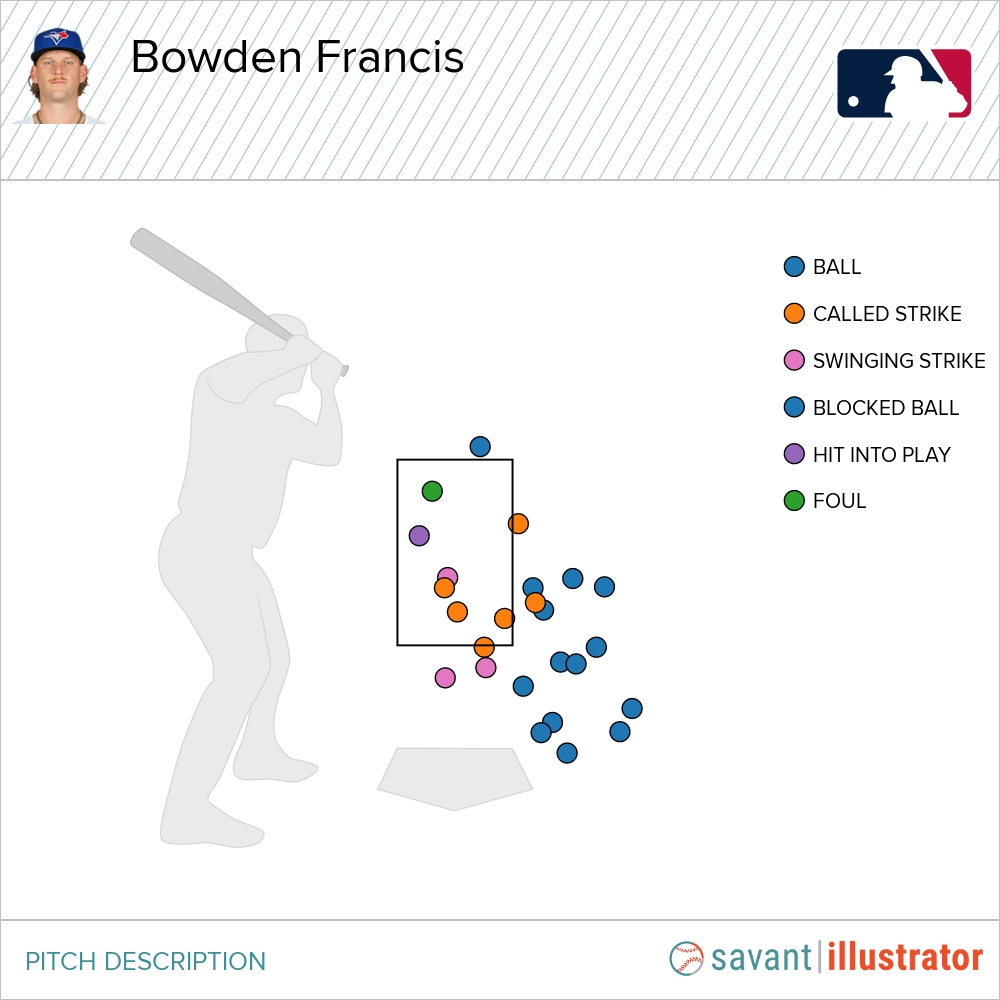By the Numbers: Take a Bowden
A dive into the changes that have improbably made Bowden Francis the AL's pitcher of the month for August.

“We have to have good stories coming from our farm system.”
That was Ross Atkins’ answer when he was asked back in June whether the Blue Jays’ farm system is good enough to power a sustainable winner. Well, at least before he backpedalled and assured us that there were “a couple of those in the last year, and they're here now in Davis Schneider, Addison Barger, Spencer Horwitz. And Nate Pearson's been encouraging.” (LOL).
“But we need that to happen again.”
For most of two months that have followed, as was the case in the previous ones, those stories didn't materialize—at least in the minors, though Vladimir Guerrero Jr.’s return to superstar status has been about as good as story as the club could have hoped for in a lost year like this.
That's not to say there have been zero good stories for Blue Jays youngsters. Arjun Nimmala’s power has impressed, Alan Roden continues to hit, young Victor Arias has produced results as eye-catching as his bat speed and exit velocity, to name just three on the position player side. But it feels like there has been a lot of bad.
Ricky Tiedemann needed Tommy John surgery, as did Alek Manoah and Brandon Barriera. Landon Maroudis had an “internal brace” procedure (i.e. not quite fully Tommy John, but close). Orelvis Martinez was suspended 80 games for performance enhancing drug use. Tucker Toman—who, at $2 million, received the second-highest bonus of any of the club’s 2022 draftees—once again didn't take a step forward, Gabriel Martinez hasn't bounced back from a rough 2023. Rafael Lantigua and Damiano Palmegiani have fallen back to earth.
Yet now, somehow, we have Bowden Francis, who has just been named the American League pitcher of the month for August. Just like we all predicted, I’m sure.
Over this last absurd stretch, Francis has taken his ERA for the season down to 3.66—pretty impressive for a guy who pitched 49% of his big league innings in the first half and entered the All-Star Break at 5.82. But, as I'm sure everyone is aware by now, that's hardly the only impressive bit of statistical magic to be found on his FanGraphs page. Or elsewhere. And far from the most impressive.
Among 129 pitchers in the month of August with at least 20 innings thrown, Francis ranked first in ERA (1.05) by four-tenths of a run. He was first in WHIP (0.41), tied for first in RA9-WAR (1.9), fifth in fWAR, second by K-BB%, sixth in strikeout rate, ninth in walk rate, fourth in SIERA, ninth in FIP, 15th in xFIP. Only five pitchers had allowed a lower maximum exit velocity in the month. He was in the top 15 by hard hit rate. He was second in win probability added.
Of course, you’ll find numbers that are even more ridiculous if you look at just his last four outings.
He’s literally been pitching at Hall of Fame level. Like, literally literally.
Now, when that collection of Cy Young winners had their sensational runs of 78+ Game Scores, they were obviously doing it because they were some of the most elite pitchers with the best stuff of their respective generations. We are, uh, probably not quite ready to stick that label on Francis just yet. He’s a guy who, as he’d tell it, is simply believing in his shit and letting it eat. The way I think more people would probably tell it is that he used to do one set of things and then suddenly started doing some different things.
But it’s really not quite as simple as either of those, is it?
Thing is, I don’t think it’s as simple as luck or unfamiliarity—the sort of things a skeptic might say—either.
Francis is hardly the first guy to ever add a new pitch, or change his usage mid-season. If it were just luck or unfamiliarity someone other than Randy, Pedro, Santana, and Kershaw would have found a way to have a stretch like this over the last 35 years. And the idea that the book isn’t out on him yet and the league will ultimately catch up is harder to believe when you remember that he’s faced a pair of teams—the Orioles and Angels—twice since returning to the rotation in late July.
Granted, Baltimore caught him just before he fully made his big changes, and the Angels are obviously not a good team, but… well… actually, we’re getting ahead of ourselves a bit here. What exactly are the changes that Francis has made?
Mostly, we’ve heard about the splitter that he’s added. And it’s certainly been a big part of his transformation, as he’s upped its usage, against both right-handed batters…
…and left-handed ones.
He’s also changed the grip he uses on it since introducing it to his arsenal earlier this season, as Buck Martinez explained on Sportsnet’s broadcast prior to Francis’s most recent start—and as Blake Murphy detailed in a piece back in June.
“He had a grip in the spring where he didn't have any seams, now he's got contact with the seam and his index finger,” Buck said, somewhere in between praising strike-throwing and calling home runs rally-killers as though Pat Tabler was still there beside him in spirit. “That gives him better command and a little bit better movement, because he's got more resistance on that index finger.”
But what you can see better in the lefty-righty splits than in his overall numbers is the way that Francis has also increased his slider usage against right-handers nearly as much as he has the split-finger. He’s not become primarily a fastball-splitter guy with the odd slider and curve mixed in, which is what his overall usage rates—51% FB, 27% FS, 12% SL, 6% CU in August—and the narrative might suggest. He’s only been that guy against left-handers, with his splitter functioning the way a changeup otherwise might—as was also explained in Blake’s piece.
“Pronating for a changeup, like how Trevor Richards throws his, wasn’t natural to Francis, and so he struggled to find a changeup with enough depth,” Blake writes. “The splitter is an off-speed weapon and his carries some similar arm-side movement.”
Against right-handers there’s a reason he’s used the slider more, with the pitch generating swing-and-miss 55.6% of the time, up from 41.7% for the season as a whole.
He also seems to have made a slight adjustment to his fastball release point—presumably to make it look as much like the splitter as possible when coming out of his hand. We can see this change in the image below: splitters are in blue, they’re followed by his fastballs from April, then his fastballs from after he returned to the majors in June.
Clearly there’s a much better overlap between the splitters and fastballs of late, likely adding to a tunnelling effect that’s well suited to the two pitches—a fastball he generally uses up in the zone and a splitter that has noticeably more drop (-36 inches compared to -14)—albeit not nearly as much as his loopy curveball (-61) or even his slider (-42).
What I also find interesting about these two pitches is that they’ve been producing nearly the exact same amount of arm-side run, especially lately.
Looking at his heatmaps should help us put together some of what is going on.
Below we see his fastballs and splitters to right-handed batters in the month of August. The fastballs are, of course, the ones he's mostly trying to keep up and away in the zone. The splitters are mostly either coming in low and inside, or catching the top inside corner.
If a batter isn’t able to pick up on the splitter early, the ones end up in that lower cluster are going to look a whole lot like fastballs that are about to miss belt-high on the inner half. If you guess wrong, you’re likely either going swing over top of it (37.5% swing-and-miss rate in August) or make some ugly contact (.052 xWOBA).
The high-and-inside ones will look fairly harmless before dropping in for a strike—and as we can see, and would expect, this is where he’s been getting a bunch of called strikes on it.
But let’s get back to that slider. It's never been a great pitch for him, and has always been clearly his third offering, never topping even 23% of his pitches thrown to right-handers in a single season. But with RHB now having to look for fastballs up, splitters in, and sliders down and away—instead of essentially either just a fastball or something breaking away from them—it seems to have increased his effectiveness across the board. It probably also doesn’t hurt that the slider is coming in at just about the same velocity as the splitter.
Granted, the few of his sliders that have been put into play by RHB have been hit hard, and he’s not using it as a putaway pitch—with two strikes to right-handers in August he was mostly fastball (52%)/splitter (35%)—but the swing-and-miss has helped him get back into counts. And also ahead in the first place.
Another fascinating element of the transformation is the way that Francis has been sequencing. For example, in the way he’s been starting off right-handed batters during this stretch. In August he used his fastball 40% of the time in 0-0 counts against RHB, and his slider 37% of the time. The splitter, curve, and change have each been used just 5-10%. Not what we’d expect but, perhaps because hitters have the newfangled splitter on their brains, they’ve not been able to do anything with the slider except lay off when he misses.
Here we see the locations and results of the first pitch sliders Francis has thrown since his June 29th start in Baltimore:
He’s also mixing in the occasional sinker, according to Statcast, and still has the curve in his back pocket as well. True Bassitt-ification, with a hint of Gausmania.
And, of course, as Buck would (rightly and repeatedly) let you know, command has also been a key element as well. Francis has done a very good job of keeping the ball in the zone since the start of August, ranking 17th of 129 pitchers with at least 20 innings in the month by Zone% according to Statcast. If you look at something like Stuff+, we see just how important this has been: according to the modelling his splitter has been good but not quite elite when compared to other splitter-throwers, and his other stuff has been fairly pedestrian. He ranked just 71st of 129 pitchers in August by Stuff+, but by Location+ he was 22nd, and overall by Pitching+ he ranked eighth.
Not exactly Hall of Fame stuff—or Stuff, as it were—but it feels like he’s got some very interesting ingredients to work with, as long as he can continue to command the ball and keep right-handed batters off-balance with his revamped arsenal. I know it’s been quick, I know there are surely things other teams’ advance scouts haven’t quite figured out about him yet, and I know that a hot six weeks in Buffalo at the end of last year had me far too intrigued by Mitch White. But this isn’t based on a velocity bump with a side of hope, or even a new pitch, really. It’s about some pretty fundamental changes. It’s about changes that make sense when you think them through, and ones that have propelled him to previously unthinkable success over 40 innings and 140 batters faced—a much more impressive body of work than if we were talking about, say, a hitter on a two-week hot streak.
I genuinely think there’s something there. At least a credible back-end starter to pencil in going forward, unless the bottom completely falls out in his next couple outings. I guess we’ll see on Wednesday night. But, oh man, if he keeps on rolling what an incredibly good story for this team that would be.
Twitter ⚾ Facebook⚾ Bluesky ⚾ Podcast ⚾ YouTube
⚾ Want to support without going through Substack? You could always send cash to stoeten@gmail.com on Paypal or via Interac e-Transfer. I assure you I won’t say no. ⚾














His one month heater alone is probably worth more than Rowdy produced as a Brewer his entire career.... checks notes, rough math: 0.3 WAR for Rowdy, seems about right. And I like Rowdy.
The other day I did a quick search for a spring training quote from Bassit predicting a breakout season for Francis. Don’t think it meant much more than positivity from a teammate especially since it seems mid season changes played a big part in recent success. But I can’t get the quote out of my head. Mostly because I can’t find it. Does anybody else remember it? Or maybe I imagined it?